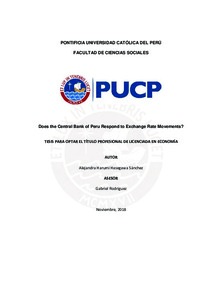| dc.contributor.advisor | Rodríguez Briones, Gabriel Hende | es_ES |
| dc.contributor.author | Hasegawa Sánchez, Alejandra Harumi | |
| dc.date.accessioned | 2018-12-07T00:16:34Z | es_ES |
| dc.date.available | 2018-12-07T00:16:34Z | es_ES |
| dc.date.created | 2018 | es_ES |
| dc.date.issued | 2018-12-06 | es_ES |
| dc.identifier.uri | http://hdl.handle.net/20.500.12404/13098 | |
| dc.description.abstract | El objetivo de esta investigación es investigar si los movimientos del tipo de cambio nominal
afectan la fijación de la tasa de interés de política monetaria en Perú. Estimamos un
modelo de equilibrio general dinámico estocástico (DSGE, siglas en inglés) neokeynesiano
de una economía pequeña y abierta con hogares, dos sectores productivos de exportación
(commodities y manufacturados) y un sector externo, basado en el modelo desarrollado
por Schmitt-Grohé y Uribe (2017). El modelo considera mercados incompletos, rigidez de
precios a la Calvo y una regla de política monetaria que responde a cambios en la infación, el
producto bruto interno y tipo de cambio nominal. Adicionalmente, se incluye una condición
de paridad de la tasa de interés modificada que captura la intervención cambiaria, que ha
sido utilizada activamente por el Banco Central del Perú desde principios de los años 90.
Estimamos cuatro especi caciones del modelo por métodos bayesianos para los periodos
1T2002-4T2017 y 1T2010-4T2017, cuando el Banco Central del Perú sigue un régimen de
metas de in ación. El principal resultado sugiere que la importancia del tipo de cambio
nominal en la regla de política monetaria del Banco Central del Perú ha disminuido desde
el 2010, lo que puede atribuirse al proceso de desdolarización de la economía peruana y la
consolidación del régimen de metas de in ación. Durante el período 1T2020-4T2017, el
Banco Central racionaliza su esquema de metas de inflación con instrumentos para limitar
los riesgos vinculados a la dolarización e interviene en el mercado de divisas. Además,
encontramos que la intervención en el mercado cambiario ha sido una característica relevante
del mercado cambiario en Perú y de la determinación del tipo de cambio | es_ES |
| dc.description.abstract | The aim of this paper is to investigate whether exchange rate movements affect the monetary
policy interest rate setting in Peru. We estimate a New Keynesian Dynamic Stochastic
General Equilibrium (DSGE) model of a small open economy with households, two productive
export sectors (commodities and manufacturing) and a foreign sector, based on the
model developed by Schmitt-Grohé and Uribe (2017). The model considers incomplete
markets, sticky prices a la Calvo and a monetary policy rule that responds to changes in in-
ation, output and in the nominal exchange rate. Additionaly, we include a modi ed interest
rate parity condition that captures foreign exchange intervention, which has been actively
used by the Central Bank of Peru since early 90s. We estimate four speci cations of the
model by Bayesian methods for the periods 2002Q1-2017Q4 and 2010Q1-2017Q4, when
the Central Bank of Peru follows an in ation targeting regime. The main result suggests
that the importance of the nominal exchange rate in the Central Bank of Peru's interest
rate policy rule has decreased since 2010, which can be attributed to the de-dollarization
process of the Peruvian economy and the consolidation of the in ation targeting regime.
During 2010Q1-2017Q4, the Central Bank rationalizes its in ation targeting scheme with
instruments to limit risks linked to dollarization and intervenes in the foreign exchange market.
In addition, we nd that foreign exchange market intervention has remained a relevant
feature of the foreign exchange market in Peru and of the determination of the exchange rate. | es_ES |
| dc.language.iso | eng | es_ES |
| dc.publisher | Pontificia Universidad Católica del Perú | es_ES |
| dc.rights | info:eu-repo/semantics/openAccess | es_ES |
| dc.rights.uri | http://creativecommons.org/licenses/by-nc-nd/2.5/pe/ | * |
| dc.subject | Política monetaria--Perú | es_ES |
| dc.subject | Tipos de cambio--Perú | es_ES |
| dc.subject | Tasas de interés--Efectos de la inflación--Perú | es_ES |
| dc.title | Does the Central Bank of Peru respond to exchange rate movements? | es_ES |
| dc.type | info:eu-repo/semantics/bachelorThesis | es_ES |
| thesis.degree.name | Licenciado en Economía | es_ES |
| thesis.degree.level | Título Profesional | es_ES |
| thesis.degree.grantor | Pontificia Universidad Católica del Perú. Facultad de Ciencias Sociales | es_ES |
| thesis.degree.discipline | Economía | es_ES |
| renati.discipline | 421016 | es_ES |
| renati.level | https://purl.org/pe-repo/renati/level#tituloProfesional | es_ES |
| renati.type | https://purl.org/pe-repo/renati/type#tesis | es_ES |
| dc.publisher.country | PE | es_ES |
| dc.subject.ocde | https://purl.org/pe-repo/ocde/ford#5.02.01 | es_ES |






